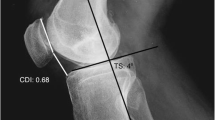Abstract
Introduction
Intraligamentary correctional operations like a high tibial osteotomy were performed in genua valga to prevent later medial gonarthrosis especially in younger patients. An unwanted effect of this method seems to be the inferiorization of the patella. This is feared because of the complications in case of subsequent alloarthroplasty. Besides the classical Coventry method as a subtractive osteotomy the hemicallotasis has been established as a sustainable additive procedure. This means a gradual open wedge correction using an external fixateur.
Objective
The aim of this study was to determine the position of the patella pre- and postoperatively and in follow-ups with subtractive versus additive intraligamentary high tibial osteotomies on the basis of five radiological parameters. It was expected that an additive osteotomy leads to an inferiorized patella position whereas a subtractive osteotomy leads postoperative to a higher position of the tibia.
Method
Between 1990 and 2001, 54 patients (61 legs) had undergone an operation due to a genu varum either by the subtractive osteotomy (n = 30) according to Coventry’s method or the additive gradually hemicallotasis (n = 31) with an external fixator.
Results
In coherence with the Coventry’s osteotomy a significant inferiorization of the postoperative patella position with all five radiological parameters was observed, the hemicallotasis showed no operation-related significant alteration of the patella height. Instancing the Insall–Salvati Index there were four (12.9%) preoperative and three (9.7%) postoperative patella baja positions detected. Along with the subtractive osteotomy there were 5 preoperative patellae baja (16.7%) and 11 postoperative patellae baja (36.7%) positions. Furthermore a significant interrelation was noticed between the extent of the correctional angle and the postoperative alteration of the patella.
Conclusion
The results are surprising, contrary was expected. First this can be explained by its gradual, additive correctional property in contrast to the spontaneous correction by the conventional method according to Coventry, second by the postoperative treatment, which allows an early mobilization and active remedial gymnastics, provided an impact resistant osteosynthesis by a fixateur externe is given. In the case of the additive hemicallotasis an intraligamentary osteotomy is recommended. Technically expensive step cuts in order to osteotomize below the tuberositas tibiae are not necessary. Due to the low quota of complications and the small operative expense the continuous distraction is preferential to ad hoc correction. A postoperative patella baja position has not to be afraid in hemicallotasis.





Similar content being viewed by others
References
Baums MH, Esenwein SA, Klinger HM (2005) An open wedge tibial head osteotomy using continuous callus distraction. An alternative method for the treatment of varus arthrosis. Unfallchirurg 108:43–48
Berg EE, Mason SL, Lucas MJ (1996) Patellar height ratios: a comparison of four measurement methods. Am J Sports Med 24:218–221
Blackburne JS, Peel TE (1977) A new method of measuring patellar height. J Bone Joint Surg (Br) 59:241–242
Caton J (1989) Methode de mesure de la hauteur de la rotule. Acta Orthop Belg 55:385–386
Closkey RF, Windsor RE (2001) Alterations in the patella after high tibial or distal femoral osteotomy. Clin Orthop 389:51–56
Coventry MB (1979) Upper tibial osteotomy for gonarthrosis: the evolution of the operation in the last 18 years and long term results. Orthop Clin North Am 10:191–210
Coventry MB, Ilstrup DM, Wallrichs SL (1993) Proximal tibial osteotomy. J Bone Joint Surg Am 75A:196–201
Feldman DS, Madan SS, Ruchelsman DE, Sala DA, Lehman WB (2006) Accuracy of correction of tibia vara acute versus gradual correction. J Pediatr Orthop 26:794–798
Grelsamer RP, Meadows S (1992) The modified Insall–Salvati ratio for assessment of patellar height. Clin Orthop 282:170–176
Grelshamer RP, Proctor CS, Bazos AN (1994) Evaluation of patellar shape in the sagittal plane: a clinical analysis. Am J Sports Med 22:61–66
Insall J, Salvati E (1971) Patella position in the normal knee joint. Radiology 101:101–104
Insall J, Joseph DH, Msika C (1984) High tibial osteotomy for varus gonarthrosis. A long-term follow-up study. J Bone Joint Surg Am 66A:1040–1048
Kitson J, Weale AE, Lee AS, MacEachern AG (2001) Patellar tendon length following opening wedge high tibial osteotomy using an external fixator with particular reference to later total knee replacement. Injury 32:140–143
Klinger HM, Lorenz F, Härer T (2001) Open wedge tibial osteotomy by hemicallotasis for medial compartment osteoarthritis. Arch Orthop Trauma Surg 121:245–247
Lobenhoffer P, Agneskirchner J, Zoch W (2004) Open valgus alignment osteotomy of the proximal tibia with fixation by medial plate fixator. Orthopade 33:153–160
Magyar G, Toksvig-Larsen S, Lindstrand A (1998) Open wedge tibial osteotomy by callus distraction in gonarthrosis. Acta Orthop Scand 69:147–151
Magyar G, Toksvig-Larsen S, Lindstrand A (1999) Hemicallotasis open-wedge osteotomy for osteoarthritis of the knee. J Bone Joint Surg Br 81B:449–451
Miura H, Kawamura H, Nagamine R, Urabe K, Iwamoto Y (1997) Is patellar height really lower after high tibial osteotomy. Fukuoka Igaku Zasshi 88:261–266
Ohsawa S, Hukuda K, Inamori Y, Yasui N (2006) High tibial osteotomy for osteoarthritis of the knee with varus deformity utilizing the hemicallotasis method. Arch Orthop Trauma Surg 126:588–593
Scuderi GR, Windsor RE, Insall JN (1989) Observations on patellar height after proximal tibial osteotomy. J Bone Joint Surg Am 71A:245–248
Seil R, Muller B, Georg T, Kohn D, Rupp S (2000) Reliability and interobserver variability in radiological patellar height ratios. Knee Surg Sports Traumatol Arthrosc 8:231–236
W-Dahl A, Toksvig-Larsen S, Roos EM (2005) A 2-year prospective study of patient-relevant outcomes in patients operated on for knee osteoarthritis with tibial osteotomy. BMC Musculoskelet Disord 6:18
Weale AE, Lee AS, MacEachern AG (2001) High tibial osteotomy using a dynamic axial external fixator. Clin Orthop 382:154–167
Conflict of interest statement
The authors report no conflict of interest. None of the authors received financial support for this study.
Author information
Authors and Affiliations
Corresponding author
Rights and permissions
About this article
Cite this article
Schiedel, F., Probst, A., Buller, T.C. et al. The postoperative patella height: a comparison of additive and subtractive high tibial osteotomy in correcting the genu varum. Arch Orthop Trauma Surg 129, 1271–1277 (2009). https://doi.org/10.1007/s00402-009-0824-x
Received:
Published:
Issue Date:
DOI: https://doi.org/10.1007/s00402-009-0824-x




